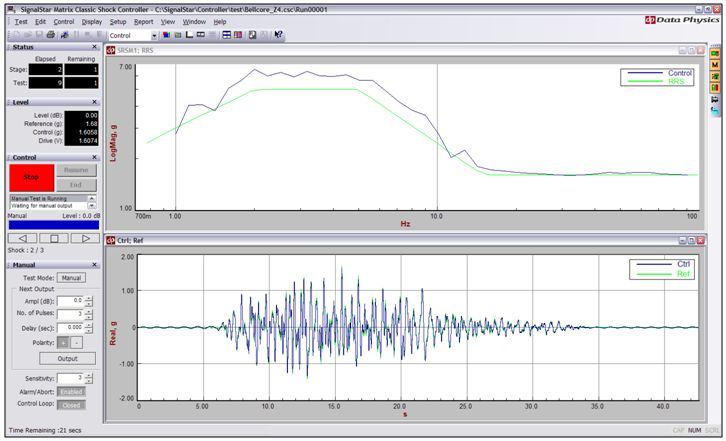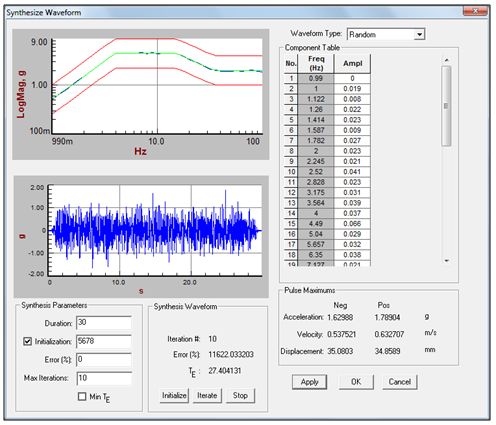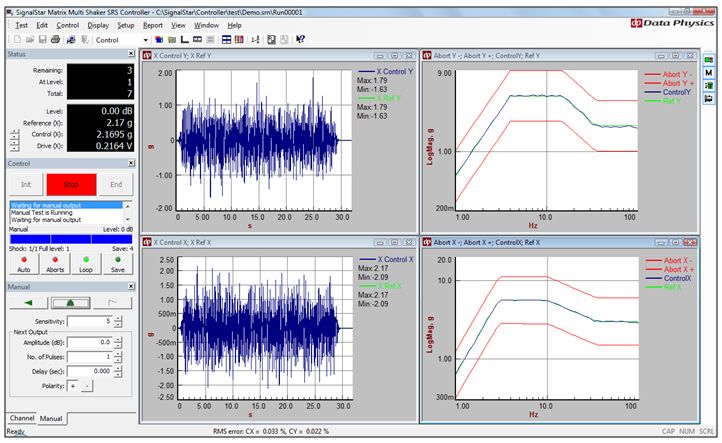With the tragic earthquake and resulting tsunami in Japan last year, there is an increased focus on ensuring that critical equipment can withstand earthquake forces. The Data Physics SignalStar Vector and Matrix controllers are important tools in qualifying this equipment. Many manufacturers of equipment and test laboratories are increasing their capacity for conducting seismic tests.
Seismic testing involves long duration, low frequency, high displacement, and shock testing. The test specifications vary by industry, but typically require control of a 30 to 60 second transient pulse and Shock Response Spectra Analysis to verify compliance with the test requirements.
There are three main test specifications that have been established for seismic qualification:
-
NEBS GR-63-CORE: Network Equipment-Building System Requirements for the Telecommunications Industry.
-
IEEE 344-2004: Recommended Practice for Seismic Qualification of Class 1E Equipment for Nuclear Power Generating Stations.
-
ICC-ES AC156: Certification of critical equipment for hospitals, schools, government, emergency shelters, and public places.
The NEBS GR-63-CORE is a single axis test, while the IEEE 344 and AC156 test are multi axial tests.
NEBS GR-63-CORE
The NEBS GR-63-CORE specification is more commonly referred to as a “Bellcore” earthquake test. It includes a set of safety, spatial, and environmental design guidelines applied to telecommunications equipment in the United States. NEBS is designed to ensure that telephones and internet access equipment work after an earthquake or thunderstorm.
The NEBS concept was first introduced by Bell Labs in the 1970s to simplify the design and deployment of telecommunications equipment in the Bell System. Telcordia and its predecessor, Bellcore, have maintained the NEBS documents since the divestiture of the Bell System in 1984. NEBS requirements are utilized all over the world for a host of commercial, utility, and defense applications. Still, the most frequent application of NEBS is to design and test equipment intended for use in Regional Bell Operating Company (RBOC) central offices.
The fundamental NEBS earthquake test is a long duration single axis earthquake synthesized waveform known as VERTEQ. This test is performed on the SignalStar Vector controller using the transient control feature of the Classical Shock control software. The VERTEQ waveform is imported as the reference and the controller compensates for the dynamics of the table and test article to reproduce the earthquake pulse on the shaker. The test is typically done in a large table with hydraulic actuators for the low frequency, high displacement requirements.

NEBS GR-63-CORE Test on SignalStar Vector
IEEE-344
Recommended practices are provided for establishing procedures that will yield data to demonstrate that the Class 1E equipment can meet its performance requirements during and/or following one Safe Shutdown Earthquake (SSE) event preceded by a number of Operating Basis Earthquake (OBE) events. Safety related electronic equipment used in nuclear power generation facilities is categorized as Class 1E.
This recommended practice may be used to establish tests, analyses, or experienced based evaluations that will yield data to demonstrate Class 1E equipment performance claims or to evaluate and verify performance of devices and assemblies as part of an overall qualification effort. Common methods currently in use for seismic qualification by test are presented. Two approaches to seismic analysis are described, one based on dynamic analysis and the other on static coefficient analysis. Two approaches to experienced-based seismic evaluation are described; one is based on earthquake experience and the other is based on test experience.
The first step in multi axial IEEE 344 Shock Response Spectra (SRS) testing is the creation of shock time histories based on the required Operating Basis Earthquake (OBE) of Safe Shutdown Earthquake (SSE) SRS profiles. These time histories must be generated from random time histories and must be demonstrated to have the required stationarity and independence. The Matrix Multi Shaker SRS Synthesis software has the ability to synthesize pulses using damped sines, sine beats, and random signals.
 Synthesis of 30 sec Pulse using Random Signal
Synthesis of 30 sec Pulse using Random Signal
The creation of long duration pulses with a high sample rate can require very large time history buffers. The SignalStar Matrix allows time buffers with up to 65,536 samples. In addition, reference pulses can be synthesized and controlled that span multiple time buffers.
 SRS Control Results
SRS Control Results
The next step is the verification of stationarity and independence. One method of verification of stationarity is the use of a time slice waterfall. This measurement demonstrates that the random time history does not vary in frequency content with time.
 Time Slice Waterfall
Time Slice Waterfall
Independence can be demonstrated using a coherence measurement between control signals in different axes. Both of these measurements can be made on the Matrix Multishaker SRS control results using the SignalCalc analyzer software.
 Coherence between Control in Different Axes
Coherence between Control in Different Axes
ICC-ES AC156
The International Code Council Evaluation Services Acceptance Criteria 156 (ICC-ES AC156) is used for special seismic certification preapproval. It is a voluntary program for review and pre-approval of special seismic certifications to be used in health facilities construction in California. Triaxial shaker table testing is preferred, but testing can be performed on a range of table types including uni-axial, bi-axial, and tri-axial. Manufacturers of critical equipment like HVAC can subject their products to AC156 testing in order to get pre-approval for use in areas that are subject to earthquakes. Requirements are similar to those of IEEE 344 used in nuclear qualification testing. The criterion specifies a specific input motion to which nonstructural components should be subjected. Input motions are required to be 30 seconds in length with a stationary input motion over a broad range of frequencies. This input motion requirement is derived based on ASCE design provisions. Required response spectrum shape is derived based on building code provisions.


 惠州市瑞幸科技有限公司
惠州市瑞幸科技有限公司